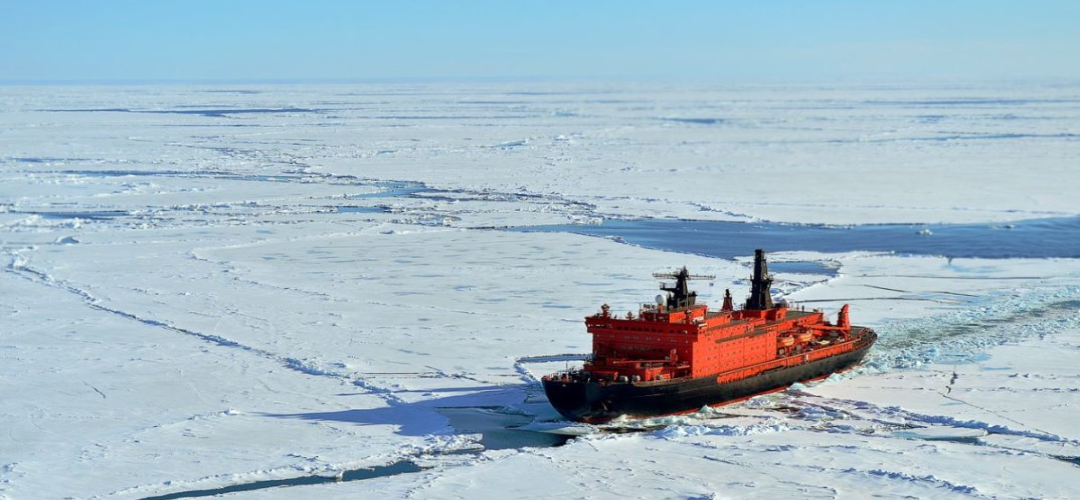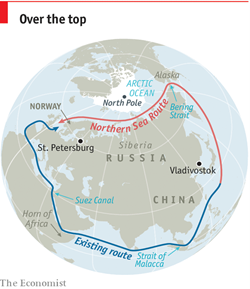NSR: Turning Into Reality
December 2, 2023 | Expert Insights

Russia's Northern Sea Route (NSR) has come under increasing scrutiny as tensions between the West and Russia exacerbate. The Northern Sea Route has long been touted as a viable and better alternative to the traditional sea route between Asia and Europe, passing through the Suez Canal and the narrow Malacca Strait. It connects the Baltic and Bering Sea along Russia's extensive Arctic coast.
As the shortest maritime route between Asia and Europe, the NSR offers an attractive route for transporting trade goods and resources like petroleum. On the one hand, the Ukraine War has caused several Western nations to draw back from Russia's NSR. On the other hand, it has also made Russia more determined to develop it as an alternative to other global routes. This resonates with several Asian nations keen to utilize the route significantly shorter than the route through the Suez Canal.
Background
The NSR comprises a set of sea routes along Russia’s northern coastline and is one of three main ways through the Arctic Ocean. Today, it is largely used for domestic purposes and exports of arctic-mined resources like petroleum and minerals. It has recently gained traction as a significantly shorter route for global trade. It is also free of the piracy risks that arise with the route through the Strait of Malacca.
While ships have traversed parts of Russia’s arctic coastline for centuries, navigation through these seas faced several challenges due to extreme weather conditions. These ranged from severe storms to pack ice blocking the way. Technological advances improved navigation through these Arctic seas. Inventions like steel-hulled icebreakers, the radio, and powerful steam engines enabled Russia to develop the NSR as a transport highway. The Soviet government opened the NSR to merchant shipping in 1935. After the collapse of the Soviet Union, the new Russian government was keen to expand economic interaction. The underused NSR was placed under Rosatomflot’s control. The Russian company constructed the world's sole nuclear-powered icebreaker fleet to open the route. While the route's main cargo consists of petroleum products, there are hopes to broaden the range to include agricultural products and fish.
The harsh sanctions due to the Ukraine war have made Russia keener to find export alternatives, pushing the NSR up to become a high priority. Russia recently announced that it aims to launch year-round navigation in a part of the route. The Kremlin is also banking on heightened interest in the NSR from countries like China, India, Japan, South Korea, and Southeast Asian countries, driven by energy demand and its convenience as a shorter route. Russia aspires to grow NSR traffic to compete with other global routes such as the Suez Canal and the Straits of Malacca. It recently approved a new development for the NSR that will be effective till 2035.

Analysis
The Russian scheme for navigating the NSR is recognized by several countries but contested by others – most notably the U.S. Fractious relations between the West and Russia since the Ukraine war have brought the NSR into focus. A new Russian law regulating the navigation of foreign warships in the NSR has sparked international controversy. The existing disagreement over the route’s legal status has been intensified by the new act, which controls the access of warships to Russia’s internal waters. A possible FONOP (Freedom of Navigation Operation) by the U.S. in the NSR is restricted by the hazards involved.
China is keenly interested in the NSR and refers to it as the "Golden Waterway". It aims to establish new trade routes in the Arctic to benefit from its global connectivity and promote Arctic exploration. Russia welcomes this interest and China's contribution to developing the NSR. In addition to a shorter route to Europe, it also offers a trade route between China and Russia; trade has increased between the two countries in recent years, particularly in oil. China's interest in the NSR can be summed up as diversifying its maritime routes, finding new energy sources, and achieving more efficient navigation. Militarily, it can avoid the choke point of the Malacca straits, where its merchant shipping and oil-bearing supertankers can be ambushed in the event of a war.
New Delhi and other Asia Pacific governments would benefit from the NSR as a quicker route to Europe. The reduced distance along the NSR can be as high as 50 per cent compared to current shipping lanes via the Suez Canal. For instance, while the voyage from Japan to Europe takes around 29 days via the Cape of Good Hope and 22 days via the Suez Canal, it takes ten days through the Arctic Ocean. Additionally, India would benefit from a new trade route to Russia, given its increasing trade with Russia in recent years and growing energy imports from the country. Further, given that sanctions have disrupted traditional trade routes between India and Russia, alternative trade routes could prove useful.
A significant game changer for the NSR could be climate change. Ironically, melting ice makes the NSR more attractive by improving navigational access: it opens up the passage, makes more time available during the year to transit the route, and allows more cargo to be carried. However, melting ice could also complicate the dispute over NSR waters. By 2035, it could open up passages (for a certain period in the year) that are in international waters (beyond Russian waters) – ships could traverse these waters immune from Russia's restrictions, and regular open-water vessels would be able to transit them without using icebreakers. This is provided that Russia and other nations follow international law and practices at sea.
However, until then, Russian fees and restrictions, ice blockages, and unpredictable access to the NSR due to climatic conditions will continue to challenge the NSR's viability as a shipping route.
Assessment
- With Ukraine-induced sanctions, many Western countries and others have cut down on trade with Russia, drastically reducing traffic along the NSR. Russia’s international isolation and its rift with Europe make selling the NSR as a trading route difficult.
- However, the NSR offers an attractive alternative to Europe and Russia for several Asian countries, saving time and cost, particularly for energy trade. While China is an eager candidate, given its Arctic and global ambitions and tightening relationship with Russia, the route is also an interesting prospect for India and other nations not participating in sanctions against Russia.
- Melting ice could add to legal contestations over the NSR by opening up the route to include a greater expanse. Given Russia’s rift with the West, the U.S. could contest Russian claims over the waters as more waters are uncovered, opening up an entirely new arena of US-Russia contestation.








Comments